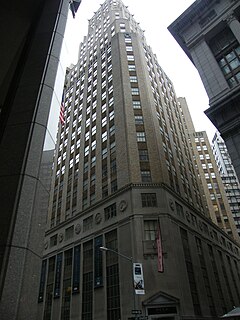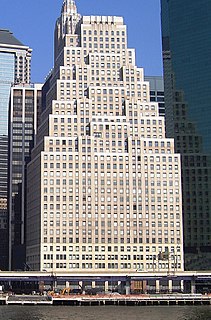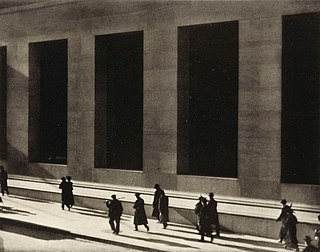 W
WWall Street is an eight-block-long street in the Financial District of Lower Manhattan in New York City. It runs between Broadway in the west to South Street and the East River in the east. The term "Wall Street" has become a metonym for the financial markets of the United States as a whole, the American financial services industry, New York–based financial interests, or the Financial District itself.
 W
W1 Wall Street is a skyscraper in the Financial District of Lower Manhattan, New York City, on the eastern side of Broadway between Wall Street and Exchange Place. 1 Wall Street, designed in the Art Deco style, is 654 feet (199 m) tall and consists of two sections. The original 50-story building was designed by Ralph Thomas Walker of the firm Voorhees, Gmelin and Walker and constructed between 1929 and 1931, while a 36-story annex to the south was designed by successor firm Voorhees, Walker Smith Smith & Haines and built from 1963 to 1965.
 W
W1 Wall Street Court is a residential building in the Financial District of Manhattan in New York City. The 15-story building, designed by Clinton and Russell in the Renaissance Revival style, was completed in 1904 at the intersection of Wall, Pearl, and Beaver Streets.
 W
W15 Broad Street is a former office building in the Financial District of Manhattan, New York City, on the eastern side of Broad Street between Wall Street and Exchange Place. It has entrances at 51 Exchange Place and 35 Wall Street.
 W
W23 Wall Street is an office building in the Financial District of Manhattan in New York City, at the southeast corner of Wall Street and Broad Street. Trowbridge & Livingston designed the four-story building in the neoclassical style. Constructed between 1913 and 1914, it was originally the headquarters of J.P. Morgan & Co.. Since the late 2000s, it has been in a state of disuse.
 W
W37 Wall Street is a luxury apartment building on Wall Street in the heart of the Financial District in Lower Manhattan, New York City.
 W
W40 Wall Street, also known as the Trump Building, is a 927-foot-tall (283 m) neo-Gothic skyscraper on Wall Street between Nassau and William streets in the Financial District of Manhattan in New York City. Erected in 1929–1930 as the headquarters of the Manhattan Company, the building was originally known as the Bank of Manhattan Trust Building, and also as the Manhattan Company Building, until its founding tenant merged to form the Chase Manhattan Bank. It was designed by H. Craig Severance with Yasuo Matsui and Shreve & Lamb.
 W
W48 Wall Street, formerly the Bank of New York & Trust Company Building, is a 32-story, 512-foot-tall (156 m) skyscraper on the corner of Wall Street and William Street in the Financial District of Lower Manhattan in New York City. Built in 1927–1929 in the Neo-Georgian and Colonial Revival styles, it was designed by Benjamin Wistar Morris.
 W
W55 Wall Street, also formerly known as the National City Bank Building, is an eight-story building on Wall Street between William and Hanover streets in the Financial District of Lower Manhattan in New York City. The lowest three stories were built in 1836–1841 as the four-story Merchants' Exchange and designed by Isaiah Rogers in the Greek Revival style. Between 1907 and 1910, McKim, Mead & White removed the original fourth story and added five floors.
 W
W60 Wall Street is a 55-story, 745-foot-tall (227 m) skyscraper on Wall Street in the Financial District of Lower Manhattan in New York City. The tower was designed by Roche-Dinkeloo and originally built for J.P. Morgan & Co.. The building's design was intended to fit its surroundings with a postmodern, Greek Revival, and neoclassical look. As of 2021, 60 Wall Street is mostly owned by GIC Singapore, with Paramount Group as minority owner.
 W
W63 Wall Street, originally the Wall and Hanover Building, is a 37-story skyscraper on Wall Street in the Financial District of Manhattan in New York City. Built in 1929, it was designed by Delano & Aldrich as the headquarters of Brown Brothers & Co..
 W
W120 Wall Street is a skyscraper in the Financial District of Lower Manhattan in New York City. It was completed in 1930. The building is 399 ft tall, has 34 floors, and is located on the easternmost portion of Wall Street, and also borders Pine Street and South Street. The architect was Ely Jacques Kahn of Buchman & Kahn.
 W
WBroad Street is a station on the BMT Nassau Street Line of the New York City Subway at the intersection of Broad and Wall Streets in the Financial District of Manhattan. It serves as the southern terminal for J trains at all times and for Z trains during rush hours in the peak direction.
 W
WThe Buttonwood Agreement is the founding document of what is now New York Stock Exchange and is one of the most important financial documents in U.S. history. The agreement organized securities trading in New York City and was signed on May 17, 1792 between 24 stockbrokers outside of 68 Wall Street. According to legend the signing took place under a buttonwood tree where their earliest transactions had occurred. The New York Stock Exchange celebrates the signing of this agreement on May 17, 1792 as its founding.
 W
WThe Continental Center is an office skyscraper located in the Financial District of Manhattan, New York City.
 W
WFederal Hall is a historic building at 26 Wall Street in the Financial District of Manhattan, New York City. The name refers to two structures on the site: a Federal style building completed in 1703, and the current Greek Revival–style building completed in 1842. While only the first building was officially called "Federal Hall", the current structure is operated by the National Park Service as a national memorial called the Federal Hall National Memorial.
 W
WThe Gallatin Bank Building was constructed in 1887 on a plot at 34 Wall Street in the Financial District of Manhattan, New York City for the Gallatin National Bank. It was enlarged from an original plot bought at 36 Wall Street when the bank was organized in 1829. The purchase price was $12,000. Originally called National Bank, the name was later changed to Gallatin because of its association with the family of Albert Gallatin. The architects were Cady, Berg & See.
 W
WThe Gillender Building was an early skyscraper in the Financial District of Manhattan in New York City. It stood on the northwest corner of Wall Street and Nassau Street, on a narrow strip of land measuring 26 by 73 feet. At the time of its completion in 1897, the Gillender Building was, depending on ranking methods, the fourth- or eighth-tallest structure in New York City.
 W
WThe Mills Building was a 10-story structure that stood at 15 Broad Street and Exchange Place in Manhattan, with an L-shaped extension to 35 Wall Street. It wrapped around the J. P. Morgan & Company Building at 23 Wall Street, on the corner of Broad and Wall Streets. George B. Post was the architect of the edifice.
 W
WThe Mortimer Building was a 19th-century building located at Wall Street and New Street in the Financial District of Manhattan, New York City. It was built by W.Y. Mortimer beginning on June 1, 1884, and completed for occupancy in March 1885. The architect was George B. Post. It fronted Wall Street for a distance of fifty-seven feet and New Street for sixty-five feet. Used entirely as an office building, the structure adjoined the New York Stock Exchange Building on the west and south. Tenants included lawyers, brokers, and bankers.
 W
WThe Tontine Coffee House was a coffeehouse in Manhattan, New York City, established in early 1793. Situated at 82 Wall Street, on the north-west corner of Water Street, it was built by a group of stockbrokers to serve as a meeting place for trade and correspondence. It was organized as a tontine, a type of investment plan, and funded by the sale of 203 shares of £200 each. The May 17, 1792, creation of the Buttonwood Agreement, which bound its signatories to trade only with each other, effectively gave rise to a new organization of tradespeople.
 W
WWall Street is a station on the IRT Broadway–Seventh Avenue Line of the New York City Subway, located at the intersection of Wall Street and William Street in the Financial District of Manhattan. It is served by the 2 train at all times and the 3 train at all times except late nights.
 W
WWall Street is a platinum palladium print photograph by the American photographer Paul Strand taken in 1915. There are currently only two vintage prints of this photograph with one at the Whitney Museum of American Art and the other, along with negatives, at the Philadelphia Museum of Art. This photograph was included in Paul Strand, circa 1916, an exhibition of photographs that exemplify his push toward modernism.
 W
WThe Wall Street bombing occurred at 12:01 pm on Thursday, September 16, 1920, in the Financial District of Manhattan, New York City. The blast killed thirty people immediately, and another ten died later of wounds sustained in the blast. There were 143 seriously injured, and the total number of injured was in the hundreds.
 W
WThe Wall Street Historic District in New York City includes part of Wall Street and parts of nearby streets in the Financial District in lower Manhattan. It includes 65 contributing buildings and one contributing structure over a 63-acre (25 ha) listed area.
 W
WWall Street is a station on the IRT Lexington Avenue Line of the New York City Subway. The station is located at the intersection of Broadway and Wall Street in the Financial District of Lower Manhattan. It is served by the 4 train at all times and the 5 train at all times except late nights.